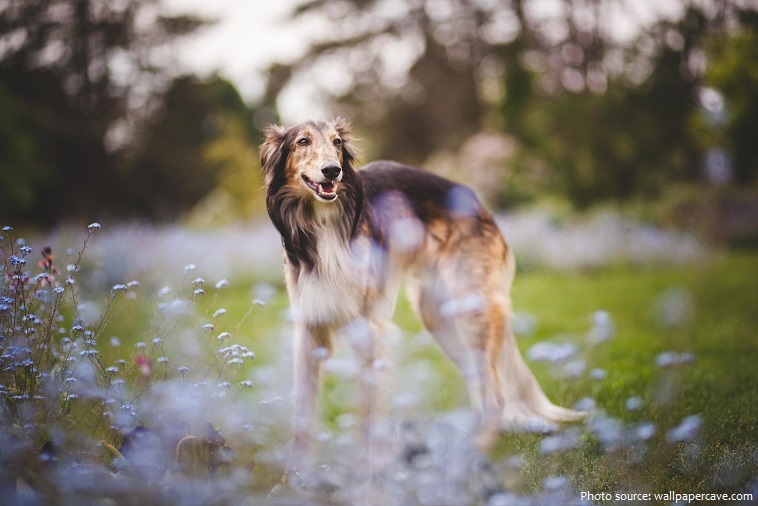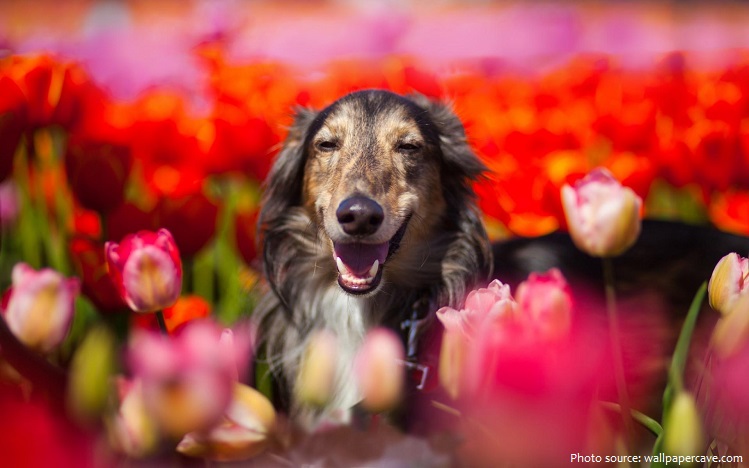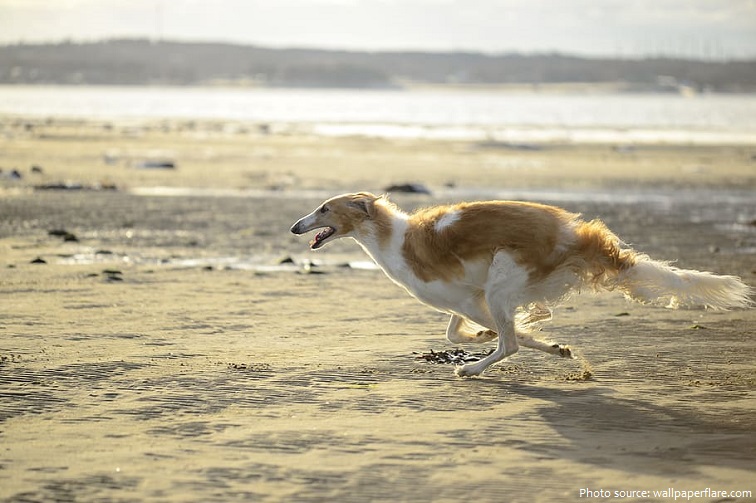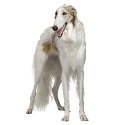
The Borzoi is a breed of hound dog developed in Russia to pursue wolves.
It is also called the Russian Hunting Sighthound and known as the Russian Wolfhound until 1936.
Appropriately, “Borzoi” is the masculine singular form of an archaic Russian adjective that means “fast.”
A dignified dog bred as regal members of the Russian aristocracy, the Borzoi has long been considered one of the most beautiful of all breeds.
Though these large, elegant sighthounds are agreeable and calm, they have an incredible ability to run at 55 to 65 km (35 to 40 miles) an hour — which isn’t surprising since underneath their luxurious silky coat is the ancient blood of the Greyhound.

Today, Borzois are affectionate and loyal family pets that possess both strength and style.
The average lifespan of the Borzoi is 7 to 10 years.
Males stand at least 71 cm (28 inches) and females 66 cm (26 inches) – weights range from 27 to 48 kg (60 to 105 pounds).
It has a long, narrow head, small ears, a deep but narrow chest, long, muscular hindquarters, and a long, curved tail.
The silky coat is flat or slightly curled and usually white with darker markings.

They originated in 17th century Russia, when Arabian greyhounds were bred with a thick-coated Russian dog.
What would become the first Borzoi standard was written in 1650, and they were bred by the Russian aristocracy for hundreds of years.
During the centuries of Romanov rule in Russia, wolf hunting was an all-consuming passion of the Russian aristocracy. Nobles would stage ritualized hunts—festivals, really—on their vast estates, with their guests, horses, and hounds ferried in on special hunt trains.
These dogs would hunt in packs, sometimes of more than 100 dogs, with just as many Foxhounds and people to assist them in their pursuit of game — which was sometimes hare and small game but wolf, more often than not.

The Borzoi was popular with the Tsars before the 1917 revolution. For centuries, Borzoi could not be purchased but only given as gifts from the Tsar. Grand Duke Nicholas Nicolaievich of Russia bred countless Borzoi at Perchino, his private estate.
The Russian concept of hunting trials was instituted during the era of the Tsars. As well as providing exciting sport, the tests were used for selecting Borzoi breeding stock – only the quickest and most intelligent hunting dogs went on to produce progeny. For the aristocracy these trials were a well-organized ceremony, sometimes going on for days, with the Borzois accompanied by mounted hunters and Foxhounds on the Russian steppe. Hares and other small game were by far the most numerous kills, but the hunters especially loved to test their dogs on wolf. If a wolf was sighted, the hunter would release a team of two or three Borzois. The dogs would pursue the wolf, attack its neck from both sides, and hold it until the hunter arrived. The classic kill was by the human hunter with a knife. Wolf trials are still a regular part of the hunting diploma for all Russian sightdog breeds of the relevant type, either singly or in pairs or trios, in their native country.

After the 1917 Revolution, wolf hunting with sighthounds soon went out of fashion as an “aristocratic” and a means- and time-consuming way of hunting. A necessity in a wolf-catching sighthound didn’t exist, in addition to the old proved technique of battue with the use of baits, flags and other appeared new, way more effective—from airplanes, from propeller sleighs, with electronic lure whistles. For decades the generations of few remaining sighthounds were regarded as hunting-suited, when showing enough attacking initiative for fox hunting. The rumours about persecution of sighthounds in post-revolutionary Russia are a legend of modern times, possibly based on similar incidents in Maoist China.
Exports of Borzoi to other countries were rare during the Soviet era, but enough of these dogs had been taken to countries including England, Scandinavia, Western Europe, and America by the late 19th century for the breed to establish itself outside its native Russia. The Borzoi is said to have made its way to America in 1889, when William Wade of Hulton, Pennsylvania brought one of these dogs over – the dog was originally purchased from Freeman Lloyd.

The Borzoi is the symbol of Alfred A. Knopf publishing house.
Tasha, a female Borzoi belonging to the noted vet Buster Lloyd-Jones (founder of Denes natural pet foods), was born in the UK during the Second World War and is the pedigree ancestor of most British Borzoi bloodlines.
Ben was the white male Borzoi, beloved of Edward J. Smith, Captain of the Titanic. There exists a photo of the Captain and his dog outside his cabin on the ship. The dog was not, however, on the maiden voyage.
Kolchak has been the mascot of the 27th Infantry Regiment since the Regiment participated in the Siberian Intervention. The 27th Infantry had been nicknamed “The Wolfhounds” in recognition of their endurance during battles in Siberia.
Today, the purebred Borzoi price is a heavy one, costing anywhere from $2,000 to $5,000 or more.
